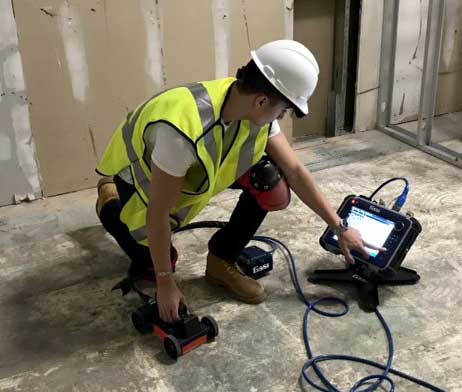Check Out RainierGPR Service Areas for Professional Concrete Scanning
Check Out RainierGPR Service Areas for Professional Concrete Scanning
Blog Article
Concrete Scanning: A Critical Step Towards Making Sure Structural Stability and Security
In the realm of construction and infrastructure maintenance, the importance of concrete scanning can not be overstated. This precise process holds the crucial to unveiling prospective hazards hidden below the surface area of relatively solid structures. By using innovative technology and techniques, concrete scanning acts as an essential tool in making sure that the stability and safety of buildings and bridges are supported to the greatest criteria. Nonetheless, beyond its surface-level effects, the function of concrete scanning expands much deeper than satisfies the eye.
Significance of Concrete Scanning
Concrete scanning plays an important duty in making sure the structural honesty and safety of structures and framework jobs. By using advanced modern technologies such as ground-penetrating radar (GPR) and electro-magnetic induction, specialists can non-destructively evaluate concrete frameworks to find possible issues, spaces, embedded items, and reinforcement format. This procedure enables early discovery of anomalies that might endanger the stability of a framework, protecting against costly damages and guaranteeing the security of passengers.
Prior to exploration, cutting, or coring right into concrete, scanning assists determine the exact locations of rebar, post-tension cables, and other ingrained elements, reducing the risk of unintentional hits that could lead to architectural weak points. Furthermore, concrete scanning aids in top quality control by validating the thickness of concrete covers and discovering any disparities that may impact the general longevity of the structure.
Technology for Concrete Examination

Advantages of Very Early Discovery
Timely detection of structural problems can significantly mitigate dangers and guarantee the longevity of construction tasks. By recognizing potential issues early on in the building procedure, stakeholders can take positive procedures to address issues prior to they rise into larger and more expensive troubles. Among the essential benefits of early discovery is the prevention of architectural failures, which can pose severe security threats and lead to task delays and financial losses.
Furthermore, early detection enables for prompt fixings and maintenance, which can help prolong the lifespan of the structure. By addressing problems without delay, construction groups can avoid pricey repair services or perhaps the demand for early replacement of structural components. This aggressive technique not only conserves money and time yet likewise improves the general security and sturdiness of the building and construction task.
In addition, early detection can boost job preparation and decision-making by providing stakeholders with important insights right into the condition of the structure. Armed with this information, job supervisors can make educated options regarding construction timelines, methods, and materials, causing more effective and effective task outcomes.
Making Certain Structural Stability
Ensuring the structural security of a building and construction task is extremely important to its safety and security and long life. Concrete scanning plays a critical duty in making certain structural security by detecting possible problems such as voids, delamination, or support deterioration that can endanger the stability of the structure over time.
By utilizing sophisticated scanning technologies like ground-penetrating radar (GPR) and electromagnetic induction, building and construction specialists can non-invasively check concrete structures to identify locations of worry underneath the surface. This aggressive strategy permits the early discovery of weaknesses or defects, making it possible for timely repair work or reinforcement to avoid architectural failures.
Normal concrete scanning during various building and construction stages and throughout the life process of a structure can help maintain its stability, mitigate risks, and ensure the security of occupants. By focusing on structural stability via concrete scanning, building jobs can boost their durability and durability, inevitably adding to better safety and security and long life.
Avoiding Crucial Failings
To guard against devastating events, careful surveillance and aggressive upkeep are important in avoiding vital failings within structural structures. Spotting possible issues prior to they intensify is essential to avoiding structural failures. Carrying out regular assessments, such as concrete scanning, can expose concealed defects like gaps, fractures, or deterioration that could jeopardize the honesty of a framework. By utilizing sophisticated scanning innovations like Ground Passing through you can try here Radar (GPR) or Concrete X-ray, engineers can non-destructively evaluate the condition of concrete and determine powerlessness that need support or repair - RainierGPR Service Areas.

Conclusion
Finally, concrete scanning plays an important duty in ensuring architectural integrity and safety by making use of advanced innovation for early detection of possible problems. This positive approach assists stop vital failings and guarantees the security of frameworks. It is important to focus on concrete examination as a typical practice to safeguard the long life and security of structures and facilities.
Concrete scanning plays a vital role in ensuring the architectural integrity and safety and security of structures and infrastructure tasks. Furthermore, concrete scanning aids in top quality control by confirming the thickness of concrete covers and identifying any type of discrepancies that might impact the total resilience of the framework. Concrete scanning plays a crucial duty in guaranteeing architectural stability by spotting potential issues such as gaps, delamination, or support corrosion that could compromise the honesty of the framework over time.

In conclusion, concrete scanning plays a crucial role in guaranteeing structural integrity and safety by making use of innovative modern technology for very early detection of prospective issues.
Report this page